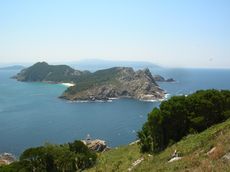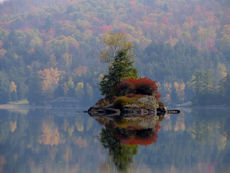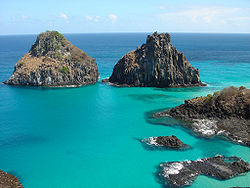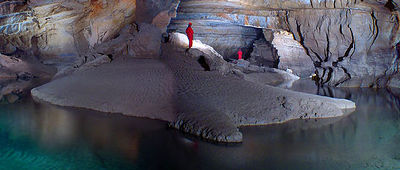Island

Cíes Islands in Galicia
|

Pokonji Dol, a small Croatian island in the Adriatic Sea
|

A small island in Lower Saranac Lake in the Adirondacks in the U.S.
|

The islands of Hawai'i are volcanic islands
|

Fernando de Noronha are submerged mountains islands
|

Wake Island is a volcanic island that has become an atoll.
|
An island (pronounced /ˈaɪlənd/) or isle (/ˈaɪl/) is any piece of sub-continental land that is surrounded by water. Very small islands such as emergent land features on atolls can be called islets, cays or keys. An island in a river or lake may be called an eyot, /ˈaɪ.ət/. A grouping of geographically or geologically related islands is called an archipelago.
An island may still be described as such despite the presence of a land bridge, for example Singapore and its causeway, or the various Dutch delta islands, such as IJsselmonde. Some places may even retain "island" in their names for historical reasons after being connected to a larger landmass by a wide land bridge, such as Coney Island.
There are two main types of islands: continental islands and oceanic islands. There are also artificial islands. There is no standard of size which distinguishes islands from islets and continents.
Contents |
Etymology
The word island comes from Old English igland (from 'ig', similarly meaning 'island' when used independently, and -land carrying its contemporary meaning). However, the spelling of the word was modified in the 15th century by association with the etymologically unrelated Old French loanword isle, which itself comes from the latin word insula.[1] Old English 'ig' is actually a cognate of Latin aqua (water).[2]
Types of island
Continental islands
Continental islands are bodies of land that lie on the continental shelf of a continent. Examples include Greenland and Sable Island off North America; Barbados and Trinidad off South America; Great Britain, Ireland and Sicily off Europe; Sumatra, Borneo and Java off Asia; and New Guinea, Tasmania and Kangaroo Island off Australia.
A special type of continental island is the microcontinental island, which results when a continent is rifted. Examples are Madagascar and Socotra off Africa; New Zealand; New Caledonia; the Kerguelen Islands; and some of the Seychelles.
Another subtype is an island or bar formed by deposition of tiny rocks where a water current loses some of its carrying capacity. An example is barrier islands, which are accumulations of sand deposited by sea currents on the continental shelf. Another example is islands in river deltas or in large rivers. While some are transitory and may disappear if the volume or speed of the current changes, others are stable and long-lived. Islets are very small islands.
Oceanic islands
Oceanic islands are ones that do not sit on continental shelves. The vast majority are volcanic in origin. The few oceanic islands that are not volcanic are tectonic in origin and arise where plate movements have lifted up the deep ocean floor to above the surface. Examples of this include Saint Peter and Paul Rocks in the Atlantic Ocean and Macquarie Island in the Pacific.
One type of volcanic oceanic island is found in a volcanic island arc. These islands arise from volcanoes where the subduction of one plate under another is occurring. Examples include the Mariana Islands, the Aleutian Islands and most of Tonga in the Pacific Ocean. Some of the Lesser Antilles and the South Sandwich Islands are the only Atlantic Ocean examples.
Another type of volcanic oceanic island occurs where an oceanic rift reaches the surface. There are two examples: Iceland, which is the world's second largest volcanic island, and Jan Mayen — both are in the Atlantic.
A third type of volcanic oceanic island is formed over volcanic hotspots. A hotspot is more or less stationary relative to the moving tectonic plate above it, so a chain of islands results as the plate drifts. Over long periods of time, this type of island is eventually "drowned" by isostatic adjustment and eroded, becoming a seamount. Plate movement across a hot-spot produces a line of islands oriented in the direction of the plate movement. An example is the Hawaiian Islands, from Hawaii to Kure, which then extends beneath the sea surface in a more northerly direction as the Emperor Seamounts. Another chain with similar orientation is the Tuamotu Archipelago; its older, northerly trend is the Line Islands. The southernmost chain is the Austral Islands, with its northerly trending part the atolls in the nation of Tuvalu. Tristan da Cunha is an example of a hotspot volcano in the Atlantic Ocean. Another hot spot in the Atlantic is the island of Surtsey, which was formed in 1963.
An atoll is an island formed from a coral reef that has grown on an eroded and submerged volcanic island. The reef rises to the surface of the water and forms a new island. Atolls are typically ring-shaped with a central lagoon. Examples include the Maldives in the Indian Ocean and Line Islands in the Pacific.
Tropical islands
There are approximately 45,000 tropical islands on Earth.[3] Among coral tropic islands for example are Maldives, Tonga, Nauru and Polynesia.[3] Granite islands include Seychelles and Tioman.[3] The socio-economic diversity of these regions ranges from the Stone Age societies in the interior of Madagascar, Borneo or Papua New Guinea to the high-tech lifestyles of the city-islands of Singapore and Hong Kong. The international tourism is a significant factor in the local economy of Seychelles, Sri Lanka, Mauritius, Réunion, Hawaii or Maldives.
Desert islands
A desert island is an island with no people. Typically, a desert island is denoted as such because it exists in a state of being deserted, or abandoned. Note that an arid desert climate is not typically implied; one dictionary uses the phrase 'desert island' to illustrate the use of 'desert' as an adjective meaning "desolate and sparsely occupied or unoccupied".[4] According to another, "A desert island is a small tropical island, where nobody lives or an undiscovered island."[5]
See also



|
|
References
- Notes
- ↑ "Island". Dictionary.com. http://dictionary.reference.com/browse/Island. Retrieved 2007-03-05.
- ↑ Ringe, Donald A. (2006). A Linguistic History of English: From Proto-Indo-European to Proto-Germanic. Oxford University Press. p. 109. ISBN 019928413X.
- ↑ 3.0 3.1 3.2 "The Tropical Islands of the Indian and Pacific Oceans". Epub.oeaw.ac.at. http://epub.oeaw.ac.at/2738-3. Retrieved 2009-01-05.
- ↑ Merriam-Webster Online, "desert" definition 2
- ↑ Collins Cobuild Dictionary (1995)
External links
- Definition of island from United Nations Convention on the Law of the Sea
- Listing of islands from United Nations Island Directory.
|
|||||||||||||||||||
